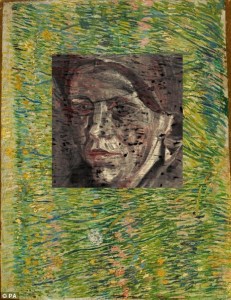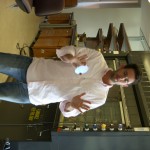Today, Giacomo Chiari from the Getty Museum gave a lecture on the science behind art conservation. This stimulated my reflection on how, although art and science are intricately related and dialogue between the two are absolutely necessary, they remain separate domains, though the border between the two may blur. The lecture reinforced in my mind how though science can help art, such as in restoration and analysis, and how art, through creativity, can further the sciences, they are not the same in my mind yet.

This picture shows how science and technology (in this case, x-ray) can be used to reveal previously unknown things about works of art-such as the hidden painting in this piece, “Patch of Grass” (that turned out to be more than just a patch of grass) by Van Gogh.
I was intrigued by the different lab visits today. I thought it was really interesting to learn about solgel technology in Dunn’s laboratory. Material development is one area of science that I am interested in because it has so many possible applications. Sol gel technology can create glass and ceramics at low temperatures, which can be used in filtration, insulation, and various bio-applications.

In Yang’s engineering lab I thought it was exciting to see how advanced a tiny, inexpensive solar cells have become in just a few years, and I am hopeful for it’s future improvement-maybe I’ll work on developing them some day, to make them last longer, have increased efficiency, and become a widespread source for energy.

Biofuels, particularly corn, were mentioned when the question “what are other forms of alternative energy” was posed. However, I don’t see this as a being a really good, plausible source of renewable energy. Growing enough biomass to be beneficial in terms of contributing energy would take up way too much space, and also, there are people living in poverty, children going to bed hungry every night that could use that produce for their survival. Transportation of course is also an issue, as is the pollution that comes with transportation. Algae, however, appears to have potential as an energy source for a more sustainable future, as algae can flourish in harsh areas and is not a dietary staple.
http://www.riverdeep.net/current/2000/06/front.230600.art.jhtml
http://www.getty.edu/conservation/science/
sol-gel: http://sgmn.immt.pwr.wroc.pl/index.php?option=content&task=view&id=6&Itemid=30
alternative energy:
http://www.fluorescentefficiency.com/articles/7-obscure-biofuel-sources-that-could-work-but-probably-wont/
http://www.popsci.com/scitech/article/2009-07/new-solar-cells-are-among-worlds-most-efficient-adjusting-sensitivity-according-latitude
http://www.popsci.com/environment/article/2008-08/new-dawn-solar-energy